Select Language

By Ankur Banerjee
SINGAPORE (Reuters) - The euro fell on Monday as the French President Emmanuel Macron called a shock election after being trounced in the European Union vote by the far-right, while the dollar was steady ahead of the Federal Reserve meeting later in the week.
The euro fell to $1.0764, its lowest since May 9, in early trading in Asia. It was last down 0.24% at $1.0776 as investors weighed the implications of renewed political uncertainty in the euro zone's second-biggest economy in a key election year.
Eurosceptic nationalists made the biggest gains in European Parliament elections in the Sunday vote, an aggregated exit poll showed, prompting Macron to take a risky gamble to try to reestablish his authority.
"The prospects of a far right victory in France's snap elections may keep the euro under pressure in the near term," said Mansoor Mohi-Uddin, chief economist at Bank Of Singapore.
"But the exchange rate is still more likely to be influenced by this week's U.S. inflation data and FOMC meeting."
The European Central Bank cut rates last week in a well-telegraphed move, but offered few hints about the outlook for monetary policy given that inflation is still above target.
The dollar index, which measures the U.S. currency against six rivals, was at 105.09, the highest since May 30, after rising 0.8% on Friday following data that showed the world's largest economy created a lot more jobs than expected in May.
U.S. nonfarm payrolls expanded by 272,000 jobs last month, data showed, while economists polled by Reuters had forecast payrolls advancing by 185,000.
Ryan Brandham, head of global capital markets for North America at Validus Risk Management, said recently the U.S. labour market data has been showing some signs of softening, supporting discussions of rate cuts in the second half of 2024.
"But this result will likely take the steam out of that conversation. The Fed has shown patience in waiting for the confidence that inflation will fully return to target before signalling rate cuts, and that caution seems warranted."
The jobs data led traders to once again shift their expectations of when the Fed will cut rates and by how much. Markets are now pricing in 36 basis points of cuts this year compared to nearly 50 bps - or at least two cuts - before the jobs data.
The chances of a rate cut in September are now at roughly 50%, from around 70% late on Thursday.
The Fed is not expected to make any change at its policy meeting this week but the focus will be on the comments from Fed Chair Jerome Powell and changes to economic projections from the policymakers. U.S. inflation data is also due on Wednesday.
"We suspect that the median dot will fall from three cuts to less than two. A hawkish hold?," said Marc Chandler, chief market strategist at Bannockburn Global Forex in New York.
The Bank of Japan is due to hold its two-day monetary policy meeting this week, with the central bank widely expected to maintain short-term interest rates in a 0-0.1% range.
The policymakers are brainstorming ways to slow its bond buying and may offer fresh guidance as early as this week, sources familiar with its thinking told Reuters, in what would be a first step to reducing its almost $5 trillion balance sheet.
The Japanese yen weakened to 156.95 in early trading on Monday. The currency remains close to the 34-year trough beyond 160 per dollar reached at the end of April, which prompted Japanese officials to spend some 9.8 trillion yen ($62.46 billion) intervening in the currency market to support it.
Sterling was flat at $1.2723 having touched $1.2700, its lowest in a week earlier in the session.
($1 = 156.9000 yen)
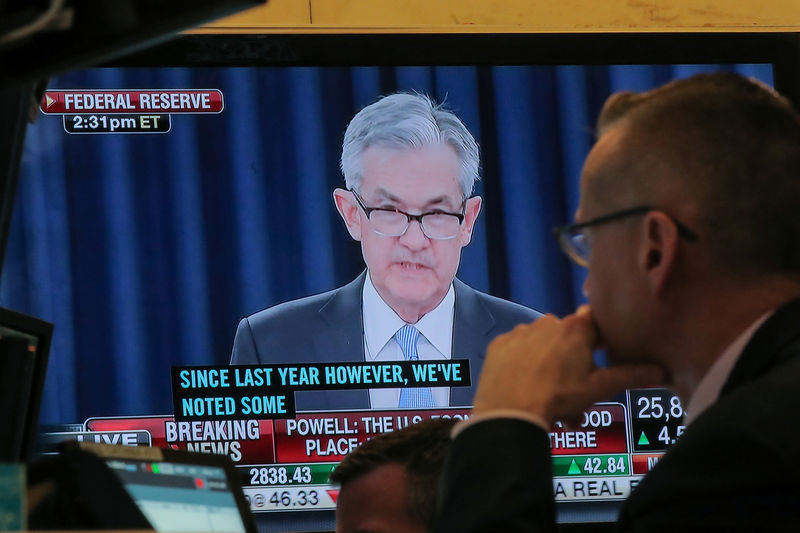
Investing.com -- The Federal Reserve is to meet as key U.S. inflation data is released. The Bank of Japan is also to meet and economic data out of the U.K. will inform the Bank of England as it contemplates rate cuts. Here's your look at what's happening in markets for the week ahead.
1. Fed decision
With the Fed widely expected to leave interest rates on hold at the conclusion of its two-day policy meeting on Wednesday market watchers are instead focused on how many rate cuts officials will signal for the rest of 2024.
The updated dot plot will likely point to two 25-basis point cuts this year, down from three in March.
Friday’s employment data, which showed both jobs and wage growth accelerated in May even though the unemployment rate ticked higher, saw markets pare back expectations for rate cuts this year, with the first rate cut now expected to come in September.
Recent comments by Fed officials have indicated they are in no rush to cut rates as inflation remains persistent and the outlook for growth remains solid.
Inflation has cooled after aggressive rate hikes starting in 2022 but has not yet fallen to its 2% target.
2. May inflation data
Inflation figures for May are due to be released just hours before the Fed statement on Wednesday. Further signs of inflation easing could cement expectations for rate cuts, especially given signs of economic weakness.
Wall Street, boosted by cooling inflation, will be watching closely. Traders continue to price in some monetary easing this year, with even some slim hopes of a July cut.
A bad inflation miss could spook investors and bring back recession fears that have laid dormant for months.
No doubt, the data could fire markets up ahead of Fed Chair Jerome Powell's post-meeting press conference.
3. Wall Street
Wall Street will be closely watching Wednesday’s inflation data and Fed meeting for clues on whether the soft-landing hopes that drove stocks to record highs are still justified.
"No one expects the Fed to cut (rates next week), but will they open the door for a cut as soon as September is the big question on everyone's mind," Ryan Detrick, chief market strategist at the Carson Group told Reuters, adding he still sees a September reduction on the table.
This year's rally has lifted the S&P 500 up more than 12% year-to-date, on expectations the Fed can cool inflation without hurting growth. Yet recent economic data have sent conflicting signals: Friday’s jobs report was far stronger than expected, while earlier reports showed a slowdown in manufacturing and a first-quarter growth rate revised lower.
“The market would like some clarity and not see the Fed have to wait until December or January to begin cutting rates,” said Paul Christopher, head of global market strategy at the Wells Fargo Investment Institute, adding a long period of elevated borrowing costs could hurt the economy.
4. UK data
Market participants will be closely watching the latest U.K. jobs report on Tuesday as they try to gauge whether wage pressures are easing fast enough to make a Bank of England rate cut a near-term prospect.
Average weekly earnings, excluding bonuses, rose by an annual 6% in the three months to March, and April's 9.8% increase to Britain's minimum wage may push that growth rate higher.
Until recently, economists expected a June rate cut but persistent inflation pressures mean markets are not now fulling pricing in a move until November.
Meanwhile, April GDP data on Wednesday is expected to show growth softened after a robust 0.6% expansion in the first quarter.
Elsewhere, the opposition Labour Party is to launch its manifesto ahead of the July 4 election. While polls suggest Labour will hammer Prime Minister Rishi Sunak's Conservatives, some business leaders doubt Labour can turn around Britain's recent weak growth performance.
5. BOJ
Bank of Japan Governor Kazuo Ueda has already hinted at some kind of taper of the bank’s long-running quantitative easing program when the BOJ concludes its two-day meeting on Friday.
On Thursday he said it would be appropriate to reduce still-massive bond purchases as the BOJ exits decades of stimulus, stressing policymakers will move "cautiously" on rate hikes after delivering its first rise since 2007 in March.
Mizuho Securities sees a good chance of a 1 trillion yen ($6.4 billion) cut in monthly purchases to roughly 5 trillion yen per month, which could be weathered by bond markets.
Whether that supports the battered yen is a separate matter, with the BOJ and government concerned a weak currency could derail a hoped-for cycle of mild inflation and steady wage gains.
--Reuters contributed to this report
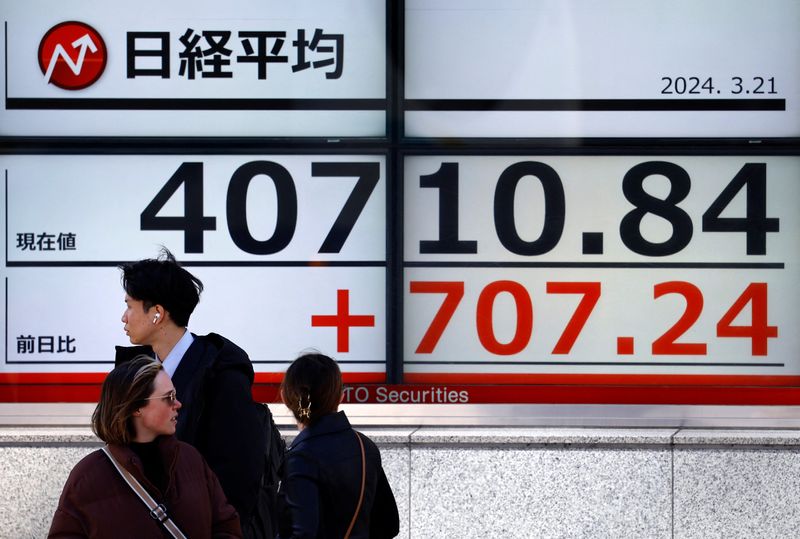
By Rae Wee
SINGAPORE (Reuters) -Asian stocks are set to snap a two-week losing streak on Friday after major central banks kick-started their rate easing cycles this week, adding to expectations the U.S. Federal Reserve could soon follow suit.
The European Central Bank (ECB) delivered a well-telegraphed rate cut on Thursday, a day after the Bank of Canada became the first G7 nation to trim its key policy rate.
The two join Sweden's Riksbank and the Swiss National Bank in beginning their respective monetary easing cycles, breathing new life into the global risk rally and as bets grow that the Fed could also cut rates in September.
"You've got two of the G7 cutting rates ... it certainly opens the door further to the Fed," said Tony Sycamore, a market analyst at IG. "We're not in the home straight, but we've certainly rounded the corner.
MSCI's broadest index of Asia-Pacific shares outside Japan rose 0.2% and was on track to end the week nearly 3% higher, though some of its gains were capped by a selloff in Chinese stocks.
Europe looked set to extend the positive momentum, with EUROSTOXX 50 futures advancing 0.02% while FTSE futures gained 0.17%. S&P 500 futures were up 0.1%, with Nasdaq futures adding 0.16%.
Market moves were largely subdued as traders stayed on guard ahead of Friday's U.S. nonfarm payrolls report, where expectations are for the world's largest economy to have added 185,000 jobs last month.
"If we did get a little softer data tonight ... We could see 10-year Treasury yields pushing down towards the 4% level," said Rob Carnell, ING's regional head of research for Asia-Pacific.
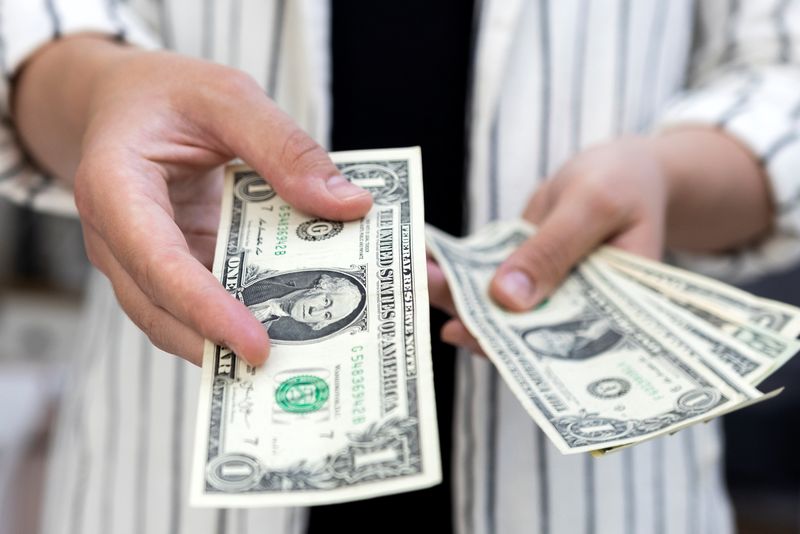
By Kevin Buckland
TOKYO (Reuters) -The dollar hovered close to an eight-week low on Friday ahead of a crucial U.S. jobs report that could provide clues on the timing of Federal Reserve interest rate cuts.
The euro held on to overnight gains after the European Central Bank reduced rates in a well-telegraphed move, but offered few hints about future easing as lingering inflation clouds the outlook.
The U.S. dollar index, which tracks the currency against the euro and five other major rivals, was little changed at 104.09 as of 0453 GMT, not far from this week's low of 103.99, the first time it had broken below 104 since April 9.
For the week, the index was on track for a 0.54% slide following a run of weaker macro data that put prompted investors to put two, quarter-point Fed rate cuts back on the table for this year.
That has seen traders positioned for a softer non-farm payrolls report later in the day, with the possibility that jobs growth comes in below the 185,000 median forecast of economists.
The Federal Open Market Committee is not expected to make any change at its policy meeting next week, but markets currently price in 50 basis points of cuts by end-December, with the first cut most likely coming in September.
"We expect the overall message from the non‑farm payrolls report to be one of strength, albeit ebbing," Joseph Capurso, head of international economics at Commonwealth Bank of Australia (OTC:CMWAY), wrote in a client note.
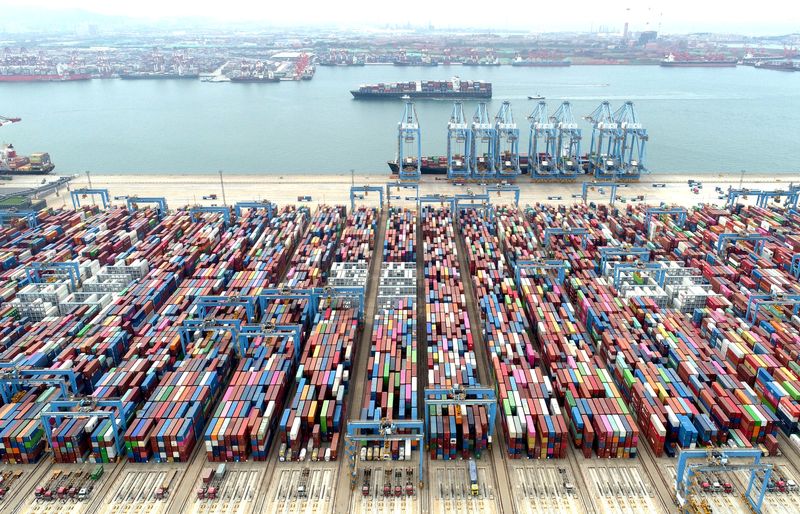
BEIJING (Reuters) - China's trade surplus with the United States was $30.8 billion in May, customs data showed on Friday, widening from the $27.24 billion surplus in April.
The trade surplus with the United States stood at $128.2 billion for January-May.
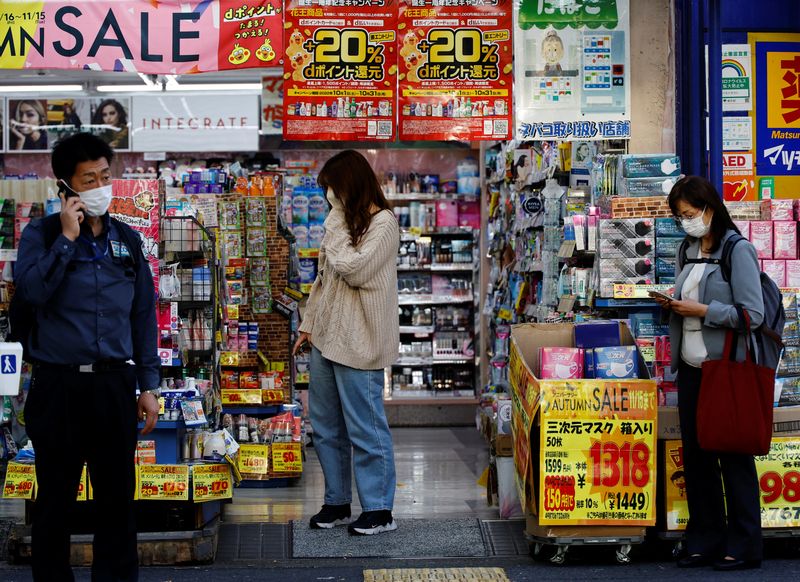
By Satoshi Sugiyama
TOKYO (Reuters) -Japanese household spending rose for the first time in 14 months in April from the year earlier, data showed on Friday, although the tepid growth showed consumers remained reluctant to loosen their purse-strings in the face of higher prices.
Consumer spending rose 0.5% in April from a year earlier, data from the internal affairs ministry showed. That was slightly below the median market forecast for a 0.6% uptick.
On a seasonally adjusted, month-on-month basis, spending fell 1.2%, versus an estimated 0.2% rise.
"Personal consumption, which has been stagnant for a long time, continues to be weak," said Masato Koike, economist at Sompo Institute Plus. "High prices are weighing on household consumption."
Sluggish private consumption is a source of concern for policymakers striving to achieve sustained economic growth underpinned by solid wages and durable inflation, which are prerequisites for normalising monetary policy.
While spending on education and clothing and footwear increased in April, expenditures in food, entertainment and utilities decreased, the government data showed.
The consumption data comes a day after a Bank of Japan board member Toyoaki Nakamura, one of the more dovish members, said domestic consumption has been sluggish recently, expressing concern that inflation may fall short of the central bank's 2% target from fiscal 2025 onwards if such conditions persist.
Separate data released on Wednesday showed Japan's regular pay in April rose at the fastest pace in nearly three decades but that inflation-adjusted wages remained weak, extending a record streak of 25 consecutive months of decline.
Going forward, consumption is expected to gradually improve as wages hikes from this spring's labour talks materialise, inflation slows down and temporary cuts in resident and income tax boost consumption, Koike at Sompo Institute Plus said.
"If consumption continues to be weak, it will be difficult to normalise the monetary policy, but real wages are expected to recover and consumption is believed to pick up, which will give (the BOJ) momentum for policy normalisation," Koike said.
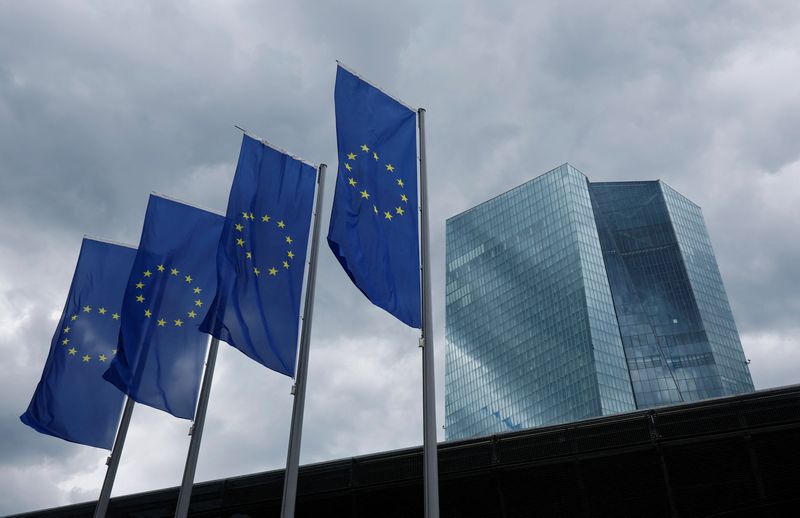
FRANKFURT (Reuters) - The European Central Bank cut interest rates for the first time in five years on Thursday but kept investors in the dark about its next move given increasing uncertainty over inflation after a sharp slowdown in the past year.
The ECB lowered its record-high deposit rate by 25 basis points to 3.75%, joining the central banks of Canada, Sweden and Switzerland in starting to unwind some of the steepest rate hikes used to tame a post-pandemic inflation surge.
Thursday's well-flagged move is seen as the start of an easing cycle, but lingering price and wage pressures are clouding the outlook and may force the euro zone's central bank to wait months before cutting again.
"The Governing Council will continue to follow a data-dependent and meeting-by-meeting approach to determining the appropriate level and duration of restriction," the ECB said in a statement.
While the ECB kept open its options for July, a string of influential policymakers, including board member Isabel Schnabel and Dutch central bank chief Klaas Knot have already made the case for a pause next month, suggesting the next window of opportunity for easing will be in September.
Economists see another two rate cuts from the ECB this year, most likely in September and December, while markets are pricing in between one and two more moves - a big change from the start of the year, when more than five cuts were anticipated.
"Interest rate decisions will be based on its assessment of the inflation outlook in light of the incoming economic and financial data, the dynamics of underlying inflation and the strength of monetary policy transmission," the ECB added. "The Governing Council is not pre-committing to a particular rate path."
Conservative policymakers, who still appear to command a majority on the rate-setting Governing Council, have argued that the ECB is not in any hurry to cut since a rebound in the economy proves high rates are not choking off growth.
Part of their caution may be due to unexpectedly stubborn inflation. Indeed, the ECB raised its 2025 inflation projection to 2.2% on Thursday from 2.0%.
"Despite the progress over recent quarters, domestic price pressures remain strong as wage growth is elevated, and inflation is likely to stay above target well into next year," the ECB said.
Some economists say the biggest risk to the rate cut schedule is actually the U.S. Federal Reserve, not wages and inflation.
The Fed has clearly signalled a delay in policy easing and a further delay in U.S. rate cuts is likely to make the ECB more cautious too, as a widening interest rate differential would weaken the euro and raise imported inflation.
Attention now turns to ECB President Christine Lagarde's press conference, where she is likely to be grilled about the ECB's likely next moves.
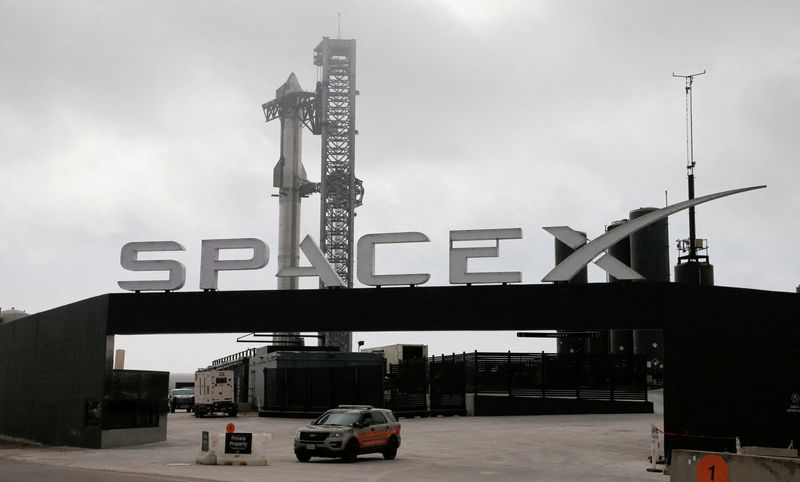
By Joey Roulette
WASHINGTON (Reuters) - The U.S. Federal Aviation Administration (FAA) on Tuesday said it issued a license for SpaceX's fourth flight of its Starship rocket system, another test mission along the company's path to building a reusable satellite launcher and moon lander.
SpaceX, owned by Elon Musk, is aiming to launch its nearly 400-foot-tall (122-meter), two-stage Starship as early as Thursday at 7 a.m. CDT (1200 GMT) from its rocket facilities in south Texas, from which past flights in the company's test-to-failure development campaign have launched.
Starship represents the future of SpaceX's dominant satellite launch and astronaut business. It is designed to be fully reusable and cheaper - but more powerful - than the company's workhorse Falcon 9. NASA plans to use Starship later this decade to land the first crew of astronauts on the moon since 1972.
Each Starship rocket has made it farther in its testing objectives than previous tests before blowing up. The first launch in April 2023 exploded minutes after liftoff, and the most recent flight in March broke apart in Earth's atmosphere as it attempted to return from space halfway around the globe.
On Thursday, the rocket system's first stage, called Super Heavy, will ignite its 33 Raptor engines to lift off, then separate from the Starship second stage, which will blast further into space.
Meanwhile, Super Heavy will reignite some engines and return toward the Gulf of Mexico for a "soft splash-down" to simulate a landing that would otherwise be on land.
In space, Starship will trek around the globe and head for the Indian Ocean, where it will make a second attempt to survive the intense heat of atmospheric reentry - the crucial point at which it failed during the March test.
"The main goal of this mission is to get much deeper into the atmosphere during reentry, ideally through max heating," Musk, CEO of SpaceX, wrote on X on Saturday.
Starship is shielded with hundreds of small black tiles on its exterior that SpaceX hopes will protect it from the extreme heat the spacecraft endures while plunging through Earth's atmosphere at hypersonic speeds.
Much is riding on SpaceX's swift development of Starship, a key pillar of NASA's moon program that rivals China's moon ambitions.
Musk's drive to rapidly build Starship has endangered SpaceX workers in Texas and California, a Reuters investigation earlier this year found.

By Anant Chandak
BENGALURU (Reuters) - Growth in India's services activity growth slowed to a five-month low in May as robust domestic demand weakened, according to a survey, which also showed exports growing at a record pace and job creation rising to a 21-month high.
The final HSBC India Services purchasing managers' index, compiled by S&P Global, fell to 60.2 last month from April's 60.8, confounding a preliminary reading for a rise to 61.4.
However, it remained above the 50 mark separating growth from contraction for the 34th straight month.
"India's service activity rose at a slightly softer pace in May, with domestic new orders easing slightly, but remaining robust, implying strong demand conditions and successful advertising," noted Maitreyi Das, global economist at HSBC.
Even though the new business sub-index - a key gauge for demand - remained robust in May, it grew at the slowest pace this year due to fierce competition and heat waves across the country hampering livelihood.
However, exports expanded at the steepest pace since the inclusion of the sub-index in the monthly survey nearly a decade ago.
With signs of recovery in China and economic activity remaining resilient in the U.S., the recent pick up in global demand could continue.
Strong sales led the business outlook for the coming 12 months to climb to an eight-month high, encouraging services firms to add jobs at the fastest pace since August 2022.
But price pressures intensified last month from April with input prices outpacing its long-run average and prices charged also quickening slightly.
"Cost pressures ticked up in May led by higher raw material and labour costs. Firms were only able to transfer a part of the price rise to customers," added Das.
That could trigger a resurge in inflation, which has largely eased this year, raising chances the Reserve Bank of India would keep interest rates on hold for a longer period and likely cut in October-December quarter compared with July-September expected earlier.
As business activity in both manufacturing and services eased slightly in May, it meant the overall HSBC India composite PMI output index fell to a five-month low of 60.5 last month from April's 61.5 and below a flash estimate of 61.7.
Sustained growth in both services and factory activity would be key focus areas for the new government elected on June 4 to ensure India continues to hold on to its title as the fastest-growing major economy in the years ahead.
India grew at a better-than-expected pace of 7.8% last quarter.

By Neil Jerome Morales and Mikhail Flores
MANILA (Reuters) -Philippine annual inflation quickened for a fourth straight month in May due largely to the faster pace of increases in housing, utility and transport costs, the statistics agency said on Wednesday.
The consumer price index rose 3.9% in May from 3.8% the previous month, marking the fastest rise since November 2023, bringing the five-month average inflation to 3.5%, well inside the central bank's 2.0%-4.0% target for the year.
Economists in a Reuters poll had forecast annual inflation at 4.0%.
The Bangko Sentral ng Pilipinas (BSP) said last month's data was consistent with its expectations that inflation could accelerate over the near term due to the impact of adverse weather conditions on farm output.
Core inflation, which strips out volatile food and energy prices, eased to 3.1% in May from 3.2% the prior month.
BSP Governor Eli Remolona reiterated on Tuesday the benchmark policy rate, currently at a 17-year high of 6.50%, could be cut before the U.S. Federal Reserve starts it easing cycle.
But Ruben Carlo Asuncion, chief economist at Manila-based Union Bank, believed the BSP would still prefer to wait for the Fed to move before it does to prevent the peso, down more than 5% against the dollar so far this year, from weakening too much.
"They may have to prioritize interest rate differentials over the speed of cuts," Asuncion said in a phone message.
The Philippine central bank, which kept its benchmark rate steady at its last five meetings, has said it was looking to cut rates by 25 basis points as early as August and by another 25 basis points in the fourth quarter.
Its next meeting is on June 27.

